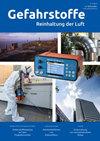Covid –19 restrictions expose air traffic at the Munich Airport as hotspot of ultrafine particle pollution – implications for regional air quality/Covid-19 Restriktionen entlarven den Flugverkehr am Flughafen München als größte Quelle der Ultrafeinstaubbelastung – Implikationen für die regionale Luftqualität
IF 0.1
4区 环境科学与生态学
Q4 ENGINEERING, CIVIL
引用次数: 0
Abstract
The massive decline of air traffic in consequence of the Covid-19 pandemic allowed a detailed analysis of aviation induced noise and particularly air pollution caused by kerosene combustion. As expected, aircraft noise is reduced significantly particularly during daytime. Notably, the particulate matter PM2.5 and PM10 officially measured as pollution load at airports is proven to be almost unchanged in ambient air. As jets do not emit coarse fine dust but solely ultrafine particles smaller than 0.1 µm (UFP), this result is no surprise. However, the dramatic reduction of ultrafine particle concentration under reduced air traffic is exemplified e.g. by 7,100 UFP/cm3 in April 2020 while in February 2020 at the Munich Airport center still 54,200 UFP/cm3 were measured. Assuming an UFP background concentration of 5,000 UFP/cm3, a decline of air traffic by 93% reduced UFP by the same magnitude. Measuring the downwind plume of the airport at varying distances the number of particles decreases while the particle size increases which is based on the fact that aircrafts emit only smallest UFP which intermix with bigger UFP from other sources around the airport. Effective measures to prevent UFP emissions are urgently needed. In addition to the use of sulfur-free kerosene, towing the aircraft during all taxiing procedures is the most effective measure to reduce UFP on ground. This work fostered the development of https://10nm.de/, which intends to provide a simulation of the potential UFP load at any airport based on wind conditions like wind direction and wind speed.(Covid—19)限制对慕尼黑机场空气质量/Covid机场的客人吸烟限制
由于Covid-19大流行导致空中交通量大幅下降,因此可以对航空引起的噪音,特别是煤油燃烧引起的空气污染进行详细分析。正如预期的那样,飞机噪音大大减少,特别是在白天。值得注意的是,被官方测量为机场污染负荷的颗粒物PM2.5和PM10被证明在环境空气中几乎没有变化。喷流喷射出的不是粗颗粒物,而是小于0.1µm (UFP)的超细颗粒物,因此这一结果并不令人意外。然而,在空中交通减少的情况下,超细颗粒浓度的急剧减少是一个例子,例如2020年4月为7100 UFP/cm3,而2020年2月在慕尼黑机场中心仍测量到54,200 UFP/cm3。假设UFP背景浓度为5,000 UFP/cm3,则空中交通减少93%将使UFP减少相同幅度。在不同距离测量机场的顺风羽流时,粒子数量减少,而粒子大小增加,这是基于飞机只发射最小的超强辐射,与机场周围其他来源的较大超强辐射混合在一起。迫切需要采取有效措施防止UFP排放。除了使用无硫煤油外,在所有滑行程序中拖拽飞机是减少地面UFP的最有效措施。这项工作促进了https://10nm.de/的发展,该网站旨在根据风向和风速等风况,模拟任何机场的潜在UFP负荷。
本文章由计算机程序翻译,如有差异,请以英文原文为准。
求助全文
约1分钟内获得全文
求助全文
来源期刊

Gefahrstoffe Reinhaltung der Luft
工程技术-工程:环境
CiteScore
0.50
自引率
33.30%
发文量
71
审稿时长
6-12 weeks
期刊介绍:
- Expertenwissen Luftemissionen und -reinhaltung.
- Filtertechniken, Lösungen zur Luftreinhaltung und Emissionsvermeidung.
- Aktueller Diskurs der Community.
 求助内容:
求助内容: 应助结果提醒方式:
应助结果提醒方式:


